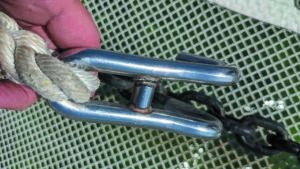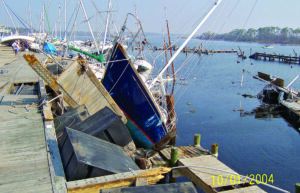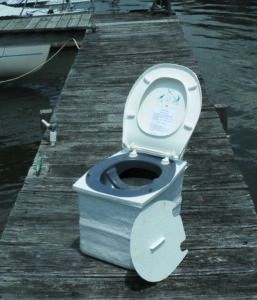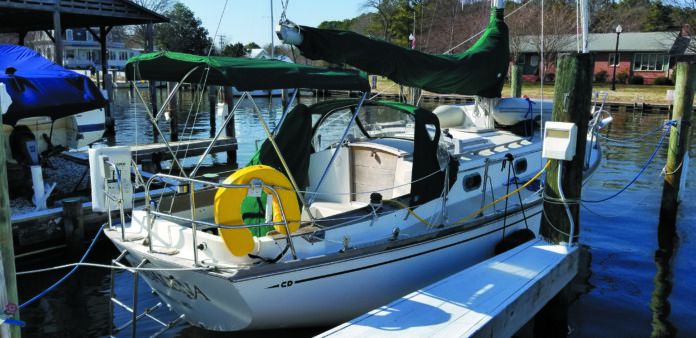SHOUT OUT FOR THE AIRMAR TLM100
Regarding your recent blog post on PFD inspection (see Inside PS, “Check Expiration Dates on Autoinflate PFDs”), when sailing solo on my Cape Dory 32 I feel much more comfortable with my kayak PFD Kokatat MsFit Tour ($165) rather than an auto-inflatable. The Kokatat has a pocket for a VHF, as well as two additional pockets, one which has my EPIRB. There’s a raft of similar choices. I’m also a member of WaterTribe (www.watertribe.com), and we have similar discussions, but with the MsFit invariably topping the leader board for men and women. Although it is designed for women, know quite a few men who also wear this version.
Kristen Greenaway
President Chesapeake Bay Maritime
Museum
Cape Dory 32
St. Michaels, MD
Thanks for the input. While the auto-inflate PFD has an important place in the offshore sailor’s safety package, inherently buoyant PFDs like yours have many advantages for coastal sailors and in high surf conditions, or vessel transfers, where mobility takes precedence over absolute buoyancy (see PS July 2019, “Rethinking the Use of Inflatable PFDs” and PS August 2020, “PFDs for Extreme Events”).
Since our last review of these types of vests, there has been an explosion of interest in stand-up paddleboards and kayaks, which are now available at very affordable prices (see PS October 2017 “Kayaks for Cruising Sailboats” and PS February 2021, “Folding Oru Opens Horizons”). Catering to this booming market, the newest crop of inherently buoyant PFDs offer a variety of styles, improved fit for women sailors, and handy features including pockets for distress signalling devices. If any readers have a favorite you’d like to see tested, we’d like to hear from you.
CAPTAIN HOOK CHAIN HOOK
My Captain Hook T-316 chain hook (C.S. Johnson 46-475) with 15 feet of 5/8-inch nylon snubber failed when I backed down pretty quickly, and the snubber jerked us to a stop. The crossbar weld failed on one side, allowing the claw to spread and lose the hold on the chain (see photo below). After that, the energy in the line and a short shock-absorbing rubber snubber (21.5” long and 1.5” diameter) caused the hook to rebound backwards. There are two problems, as I see it:

• the weld has a limited strength, not nearly that of the component pieces
• the claw is for 3/8” to 1/2” chain, so it had to bend only a little to lose grip on my 3/8” chain
It was calm conditions while backing down to set my anchor. My speed in reverse was too high, so when the chain straightened and the shock load was absorbed by the snubber, as intended, to protect the windlass and prevent dumping a lot of chain out.
I agree that this snubber isn’t long enough for an at-anchor snubber. I have a bridle for that purpose. The purpose of this hook+line+rubber is to offload the anchor tension from the windlass and to absorb small shocks during anchoring. This it did accomplish, at least until the hook failed, and I think I’m using it for its intended purpose.
John Morfit
SV Ashling, Atlantic 47 Catamaran
Deale, MD
We’ve not tested this hook and have not experienced a failure like this, but we’ve confirmed reports of similar, lightweight stainless snubber hooks bending during use. One of the reasons we are not big fans of any stainless steel for anchoring or mooring is that the material can fail without warning (see PS February 2007, “Marine Metal Warning.” Welds are particularly vulnerable. Although some stainless steel chain hooks, swivels, and shackles carry certified load ratings, far more have no load rating whatsoever—including C.S. Johnson’s Captain Hook.
At the same time as your letter, we were cc’d in another email exchange between a reader and Sam Johnson, the president of C.S. Johnson, regarding chain hook’s lack of a published working load limit (WLL). Johnson explained that publishing a load limit would expose the company to liability, even if they are used wrong. Misuse seems likely given what we’ve seen in local anchorages.
Family owned and operated since 1958, C.S. Johnson is the marine industry’s largest suppliers of lifeline fittings. According to the company’s catalogue, the “Captain Hook” chain hook can be used as follows:
“1. Use the claw and attached line to relieve tension from your windlass while anchored by snubbing the chain overboard and tying off the line to a cleat or samson post on deck.
2. Use the snubber on deck for security to hold the chain in your anchor roller and tying off on a cleat while under way for piece of mind.
3. Relieve the tension on the windlass (like in 1) by attaching the snubber to the chain in the anchor roller and pulling back and tying off securely.”
We note that yours is the largest version of the C.S. Johnson hook, but it comes with only a 15-foot threestrand 5/8-inch three-strand snubber. This is too short for effectively relieving higher loads that most cruising boats might encounter when anchored for long periods.
The good news for you is that Johnson is sending you a replacement hook free of charge. Based on your experience, the size of your boat, and several tests we’ve done with these and similar stainless steel hardware, you would be wise to use a more robust snubber hook and with your longer bridle for overnight anchoring. If you search the PS website for “snubber hook” you’ll find multiple tests with our recommendations (see PS May 2020, “A Snubber and Hook for All Occasions”). A gripping hitch is also a good option for attaching the snubber to chain (see PS August 2009, “Gripping Hitches for Loaded Lines”). Dyneema strops or webbing with high-quality, load-tested carabiners can also work for smaller boats (see PS September 2019, “Anchor Rodes for Smaller Sailboats”).
Regarding the elastic snubber you mentioned, those will reduce line chafe in a marina, but will do little to absorb the shock loads you encounter when anchoring or mooring (see PS October 2013, “Anchor Snubber Shock Load Test”).
For guidance on the proper thrust required for setting an anchor see PS November 2017 “Setting an Anchor on a Small Boat,” which contains some good advice for owners of larger boats as well.
SHOUT OUT FOR THE AIRMAR TLM100
When all of my tank indicators, including the fuel tank gauge, failed, I replaced then with Airmar ultrasonic level indicators. These mounted in the same tank holes as the previous float gages. The new gages have been in use for about two years and have been reliable so far. Readings have been at least as accurate as the float gages were. The holding tank level gages operate about as well as the fuel and water.
The system was cost effective compared to the alternatives, partly because the read out panel cost was shared over multiple tanks. I put the tank gages on a dedicated NEMA 2000 network. The tank level gages are Airmar model TLM100 paired with a single DSM410 display, interconnected with standard NEMA 2000 cables and connectors.
Airmar also sells a focus tube which is supposed to increase accuracy. I bought one for the diesel tank, but it would not fit into the existing hole. I was afraid to enlarge the hole, fearing debris would get into the tank.
Barry Needalman
S/V Island Time, 1998 Hunter 410
Winthrop, MA
Ultrasonic sensors impressed the testers in our last big round of tank sensor tests (see PS July 2009, “Tank Sensor Update”). With no floats, penetrations, or moving parts, they are unaffected by whatever is in the tank. One thing that has improved since our last test is the ease of calibrating the gages. We’ll add the TLM100 and any other reader recommended sensors to the lineup for our next test.

As a subscriber, you have free access to our back-issue archive—more than 1,500 articles. Be sure to dive in and dig around when you’re looking for how-to tips or info on sailing products. Here are a few topics you might find relevant this season.
STORM PREP
If you live in a hurricane zone, we’ve got what you need to prepare. Start with our July 2008 report, “Lines, Snubbers, and Other Gear for Battening Down Ahead of Storms” and Technical Editor Ralph Naranjo’s “Tropical Storm Do’s and Don’ts” (November 2011). For serious cruisers, PS recently published an in-depth four volume series on securing your boat at the dock, at anchor, or on a mooring for any type of storm (https://www.practical-sailor.com/product/ hurricane-preparedness-guide-complete-series).
NEW BOAT SHOPPING
The PS archive includes dozens and dozens of sailboat reviews, from trailer sailers and small cats to racer-cruisers and bluewater voyaging boats built for a family of four. Also the two-volume ebook series “Entry-level Cruiser- Racer” is a compilation of boat reviews of popular racing-cruising boats; available in online bookstore. If you’re planning to carry out a preliminary boat survey—or just want to be well-versed when you go shopping— read “Do-it-yourself survey checklist for boatbuyers,” in the June 2012 issue. Another must-read resource is “A Sailor’s Guide to Marine Insurance,” which was published in the October 2012 issue. New boatowners would also be well-served by Don Casey’s “This Old Boat,” also available at our online bookstore (www.practical-sailor.com/products).
GALLEY OUTFITTING
Before you outfit your galley, be sure to read these reviews of galley tools. For those who need quickfix dinners that can basically cook themselves while you’re on watch (or enjoying cocktail hour), you’ll find our report on pressure cookers in the December 2010 issue and thermal cookers in the May 2016 and September 2012 issues. If you are in the market for a galley oven-range combo, you’ll find our latest test on those in the July 2007 issue, along with an update on small stoves. Two other items we consider cruising-galley staples are the coffeemaker (January 2014) and nesting cookware (April 2009).

A few readers noted some discrepancies between the text and the accompanying table in our report on controlling urine odor in composting/ desiccating heads (see PS July 2021 “Additives Fight Urine Odor,” July 2021).
To clarify: Citric acid worked better than vinegar during the first days of testing, but after that vinegar was slightly better. The difference was subtle, testers did not agree, both were very effective, and many sailors will be happy with either. However, the most effective product was Nilodor.
The data in the table for CLR and Wet-and-Forget was incorrect. They did not perform well and do not rate a recommendation based on odor suppression in our opinion. For the first 3 days they were reasonably effective, but the 7-day odor is properly rated as quite noticeable; much better than no treatment or treating with sugar, but much worse than the vinegar, citric acid, and Nilodor.
Odorban was reasonably effective, and we recommended, in part, because C-head does. CLR helped a little, but is primarily recommended for cleaning the urine diverter, which it does well. However, to control odor, it should be used in conjunction with vinegar, citric acid, or Nilodor.





































